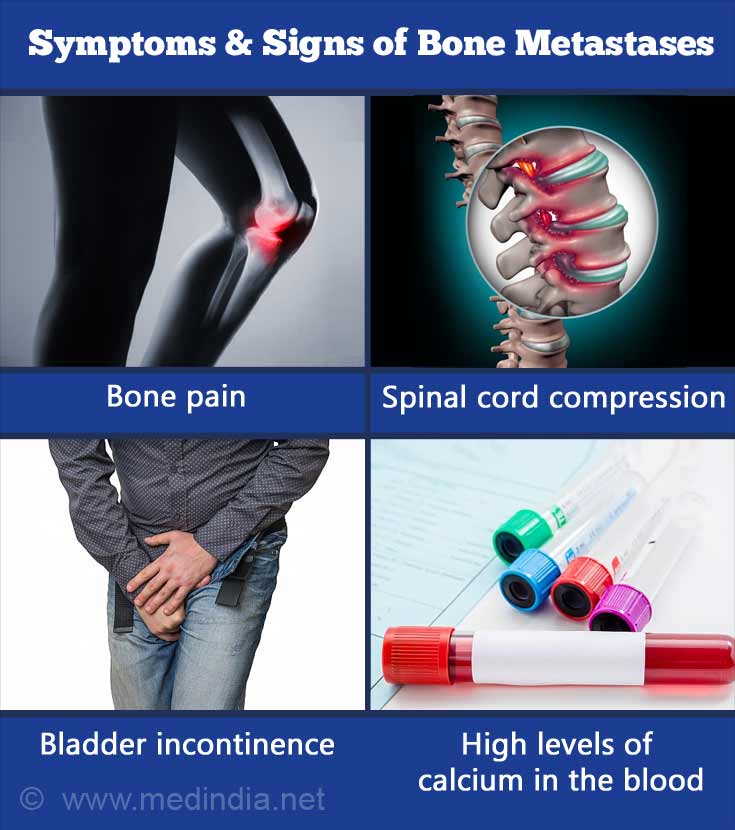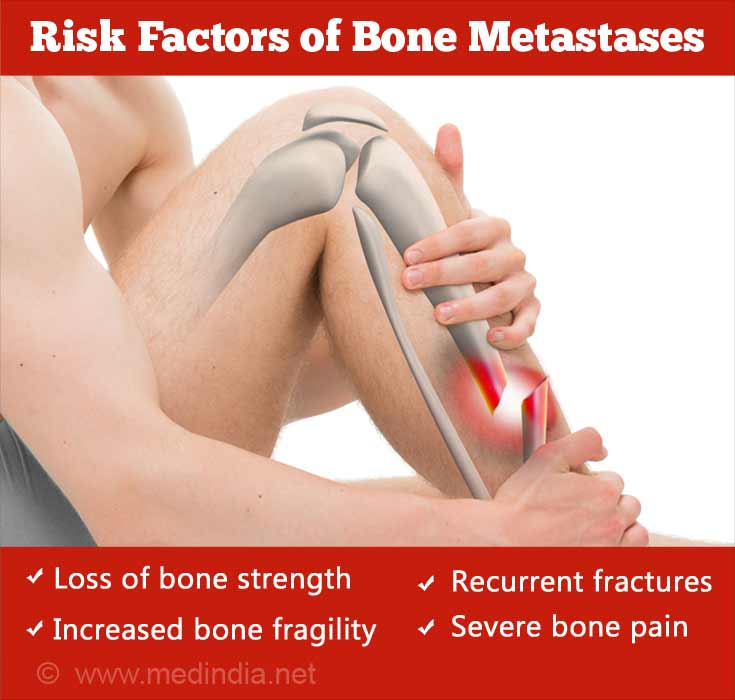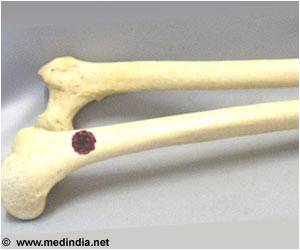- Understanding Advanced Cancer, Metastatic Cancer, and Bone Metastasis - (https://www.cancer.org/treatment/understanding-your-diagnosis/advanced-cancer/what-is.html)
- University of Rochester Medical Center- Bone Metastases: When Cancer Spreads to the Bones - (https://www.urmc.rochester.edu/encyclopedia/content.aspx?contenttypeid=34&contentid=25952-1)
- Rogel Cancer Center-Michigan Medicine- bone metastasis - (https://www.rogelcancercenter.org/bone-metastasis)
- Mayo Clinic- Diseases and Conditions-Bone metastasis - (https://www.mayoclinic.org/diseases-conditions/bone-metastasis/symptoms-causes/syc-20370191)
- Bone Metastases: An Overview by Filipa Macedo, 1 Katia Ladeira, 2 Filipa Pinho, 2 Nadine Saraiva, 1 Nuno Bonito, 1 Luisa Pinto, 2 and Francisco Goncalves 2 - (https://www.ncbi.nlm.nih.gov/pmc/articles/pmc5444408/)
- Oncolink-All About Bone Metastases- Lara Bonner Millar, MD - (https://www.oncolink.org/cancers/bone/bone-metastases/all-about-bone-metastases)
What is Bone Metastases?
Bone metastases, also called "bone mets" is a cancer that has spread from one part of the body where it initially started (the primary tumor) to the bones, and is termed secondary cancer. The cancer cells travel through the blood stream or lymph system to a part of the bone and become metastatic cancer cells.
When these cancer cells are deposited in the bone, they release substances that turn on either osteoclast cells or osteoblast cells. Osteoclast cells lead to breakdown of bone whereas osteoblast cells lead to new, abnormally hard bone being made which results in bone restructuring. Nearly all types of cancer can spread to the bones, but cancer of the lungs, breast and prostate are particularly likely to spread to bone. Once cancer has spread to the bones the prognosis is poor but proper treatment helps to slow the growth of cancer and improve your quality of life.
What are the Causes of Bone Metastases?
Bone metastases are formed from cancerous cells from another type of tissue somewhere else in your body that have started growing inside the bone tissue.
The exact cause for bone metastases is still not known. Scientists do not know what causes some cancers to spread or why some cancers of thyroid, prostate, lung or breast travel to the bones in about seventy percent of cases, rather than to other common sites for metastasis, such as the liver.
What are the Common Locations for Bone Metastases?
The most common locations for bone metastases are the hips, spine, long bones of the leg and upper arm, ribs and skull.
What are the Symptoms & Signs of Bone Metastases?

- Bone pain - This is usually the first symptom of bone metastases. The pain usually starts intermittently, is worse at night and is usually relieved with movement. It may progressively increase in intensity or become constant. Pain is more in weight bearing bones such as hip bone than in the ribs.
Fractures - This occurs because bone metastases weaken bone. Fractures that are the result of bone metastases are called "pathologic" fractures. The fractures could be caused by trauma or just by doing everyday tasks.
- Spinal cord compression - Cancer that has spread to the spine can cause pressure on the spinal cord. This may result in pain in the back or neck, numbness and weakness in the body below the tumor and difficulty walking. Spinal cord compression can also lead to nerve damage, numbness, trouble urinating and even paralysis.
- Bowel and
bladder incontinence - Weakness in the legs or arms.
- High levels of calcium in the blood (hypercalcemia) - This can cause loss of appetite, extreme thirst, nausea, vomiting, constipation, dehydration, fatigue and in very serious cases confusion and even coma.
What are the Consequences of Bone Metastases?
Bone metastases result in loss of bone strength, increased bone fragility, recurrent fractures and severe bone pain. These cause reduced mobility, recurrent hospitalization with a high rate of loss of life.

How do you Diagnose Bone Metastases?
Your doctor will firstly take a detailed medical history and then do a thorough physical examination.
- Blood tests may be performed to determine calcium levels and to check for tumor markers.
- Imaging tests may include x-ray, bone scan (bone scintigraphy), computerized tomography (CT), magnetic resonance imaging (MRI) or positron emission tomography (PET) to pinpoint the exact location of the bone metastases.
- Biopsy of bone tissue may be carried out to confirm the diagnosis by looking at the cells under a microscope.
How can you Treat Bone Metastases?
- Bisphosphonates - These medications such as Alendronate or Pamidronate are known as bone building medicines as they help bones affected by cancer to hold on to calcium, making them stronger. Bisphosphonate therapy is especially important if the metastasis is in a weight-bearing bone or is causing a great deal of pain.

- Hormone therapy - For cancers that are sensitive to hormones in the body, taking medications that block the interaction between hormones and cancer or suppress those hormones may be helpful.
- Pain medications - These medications may include over-the-counter pain relievers, such as ibuprofen or stronger prescription pain relievers, such as morphine.
- Steroids - These medications often help to relieve pain associated with bone metastases by decreasing swelling and inflammation around the sites of cancer and also prevent some cancer complications.
- Targeted therapy - For many cancers, a new class of medications known as targeted therapies is available. These medications attack specific abnormalities within the cancer cells.
- Chemotherapy - If cancer has spread to multiple bones, your doctor may recommend chemotherapy. Chemotherapy travels throughout your body to fight cancer cells. Chemotherapy can be taken orally or intravenously.
- Radiation - This therapy uses high-powered energy beams, which can be administered in one large dose or several smaller doses over many days to kill cancer cells.
- Surgery - Surgical procedures can help stabilize a bone using metal plates, screws and nails. This is known as orthopedic fixation and helps to relieve pain and improve function. Doctors may inject a broken or bone damaged by bone metastasis with cement to stabilize a bone.
- Ablation (heating and freezing cancer cells) - In this procedure a needle containing an electric probe is inserted into the bone tumor. Electricity is passed through the probe and heats the surrounding tissue. A similar procedure called cryoablation freezes the tumor.
- Radionuclide therapy (intravenous radiation) - For people with multiple bone metastases low levels of radioactive material is given intravenously. The medication deposits itself into the areas of bone that contain cancer. The radiation which is given off over a period of time kills the cancer cells.
- Physical therapy - This will help you increase your strength and improve your mobility by using methods such as heat and cold alternately, relaxation or therapeutic beds or mattresses. Assistive devices such as crutches or a walker may help to take weight off an affected bone and improve balance.
How to Prevent Bone Metastases?
Keeping the primary cancer under control and regular monitoring of the primary cancer may help to prevent bone metastases.












